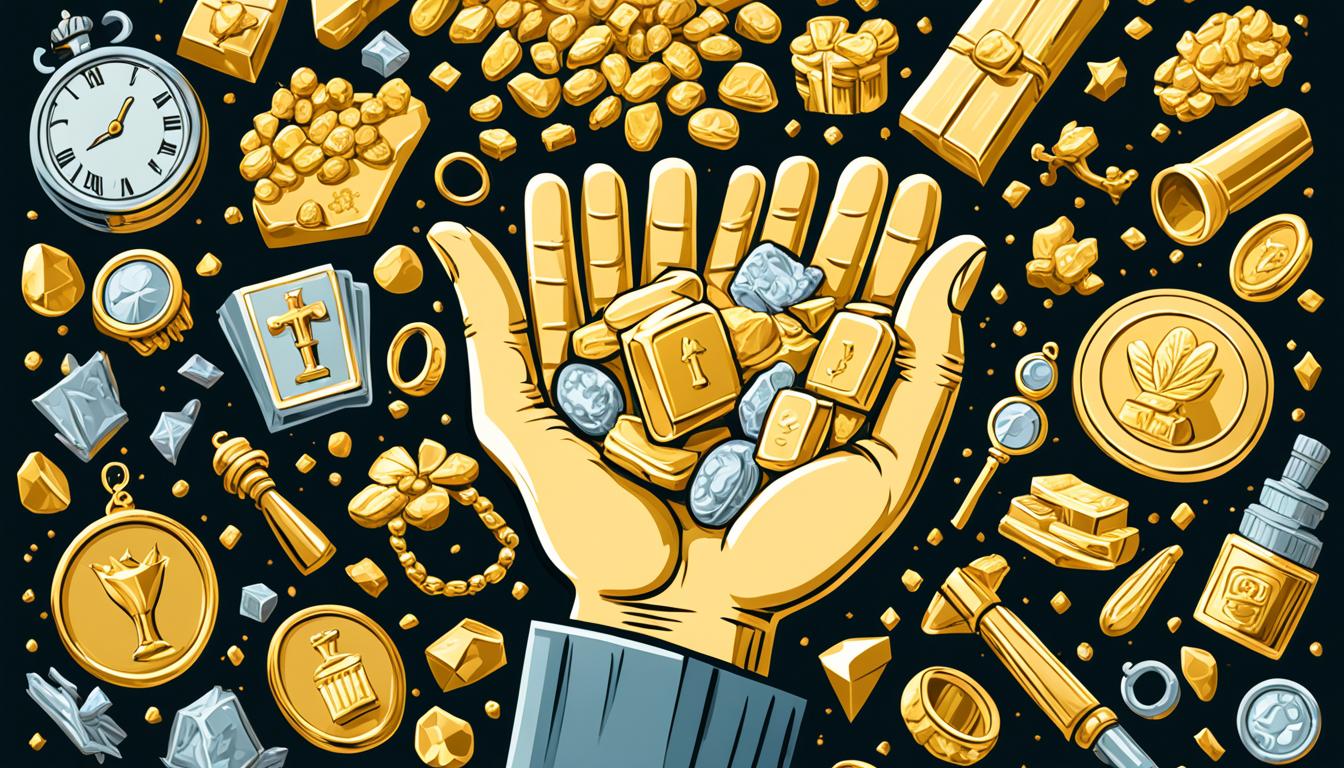Gold has captured the fascination and admiration of humanity for centuries. An alluring and precious metal, gold holds immense importance in various aspects of our lives. From its historical significance to its role as a store of value, there are several reasons why gold is highly valued.
One of the key factors contributing to gold’s value is its rarity. Unlike other metals that are abundant in nature, gold is relatively scarce. This scarcity adds to its appeal and makes it a prized possession. The difficulty of extracting gold from the earth further enhances its value.
Gold’s lustrous and metallic qualities also contribute to its desirability. Its distinctive yellow color and shine make it visually appealing, especially when used in jewelry. Gold’s malleability and noncorrosive properties make it an ideal material for creating intricate designs and lasting pieces of art.
Another reason for gold’s value lies in its historical use as a form of currency. It has served as a medium of exchange throughout different civilizations and has been considered a symbol of wealth and power. The cultural and social construction of gold as a valuable commodity further reinforces its enduring value.
Furthermore, gold’s value is influenced by various external factors. Economic conditions, geopolitical tensions, and inflation can all impact the price of gold. As a result, many individuals choose to invest in gold as a means of diversifying their portfolios and safeguarding their wealth.
Gold’s importance extends beyond its monetary value. It is used in various industries, including electronics, medicine, and aerospace, thanks to its exceptional conductivity, durability, and corrosion resistance.
In summary, the value of gold is a combination of its historical significance, scarcity, unique properties, and societal perception. Whether as a form of investment, a symbol of wealth, or a versatile material, gold holds a special place in our lives.
Key Takeaways:
- Gold’s value stems from its rarity, lustrous qualities, and historical significance.
- External factors such as economic conditions and inflation can impact the price of gold.
- Gold’s value extends beyond its monetary aspects, as it is used in various industries.
- Investing in gold can provide diversification and serve as a hedge against inflation.
- Gold holds a significant place in human history and culture.
The Symbolism and Psychology of Gold
Gold, with its radiant brilliance and timeless allure, holds significant symbolic value. Throughout history, it has been regarded as a symbol of wealth, power, and prestige. The symbolism of gold transcends cultures and civilizations, captivating the imagination and evoking awe.
Beyond its symbolic meaning, gold serves practical purposes as well. It has been used as a means of exchange for centuries, serving as a universal currency in many civilizations. When currencies falter or economies face instability, gold provides a reliable alternative form of currency, ensuring the preservation of wealth.
The psychology of gold is intriguing. Its elegance and rarity spark intrigue and desire, tapping into our innate emotional response to beauty and scarcity. The possession of gold can instill a sense of pride, status, and security, reinforcing its symbolic significance as a symbol of wealth and power.
The allure of gold extends beyond its tangible value. It has the power to evoke a range of emotions, from joy and excitement to comfort and satisfaction. This emotional connection is deeply ingrained in our collective consciousness, fueling our fascination with acquiring and owning gold.
Table: The Symbolism and Psychology of Gold
| Symbolism | Psychology |
|---|---|
| Represents wealth and power | Elicits emotions and desire |
| Enduring symbol of prestige | Evokes a sense of security and comfort |
| Transcends cultures and civilizations | Fuels fascination and intrigue |
Gold’s symbolism and psychology contribute to its enduring value. It is not just a shiny metal — it holds a place in our history, culture, and aspirations. Whether as an investment, a symbol of status, or a store of value, gold continues to captivate and inspire.
The Role of Gold as a Medium of Exchange
Gold has played a crucial role as a medium of exchange throughout history. Its enduring value and widespread acceptance made it an ideal choice for facilitating economic transactions and trade. Let’s take a closer look at the history of gold as a currency, the gold standard, and its role in trade and commerce.
The History of Gold as Currency
The use of gold as a medium of exchange dates back thousands of years. Ancient civilizations, such as the Egyptians, Greeks, and Romans, recognized the value of gold and began using it to create coins as a form of currency. The durability, scarcity, and recognizable value of gold made it a trusted means to facilitate trade and commerce.
The use of gold coins as currency continued throughout the Middle Ages and into the modern era. Gold coins were widely accepted and circulated in various regions, enabling individuals and businesses to conduct transactions with confidence.
The Gold Standard
In the 19th and early 20th centuries, many countries adopted the gold standard, a monetary system where the value of a currency is directly linked to a fixed amount of gold. Under the gold standard, currencies were pegged to a specific gold value, ensuring their stability and convertibility.
The gold standard provided a sense of security and confidence in the monetary system. It allowed for the easy conversion of paper money into gold, reassuring individuals and businesses that their currencies held intrinsic value. However, as economies grew and the demand for money increased, maintaining the gold standard became increasingly challenging.
The Abandonment of the Gold Standard
Due to the economic challenges brought about by World War I and the Great Depression, many countries were forced to abandon the gold standard. The need for increased flexibility and the inability to maintain a fixed exchange rate led to the abandonment of gold-backed currencies.
While some countries returned to the gold standard after World War II, the Bretton Woods Agreement of 1944 established a new monetary system. Under this system, the U.S. dollar was pegged to gold, and other currencies were pegged to the U.S. dollar. However, this system also proved to be unsustainable, and in 1971, President Richard Nixon ended the convertibility of the U.S. dollar into gold, effectively ending the gold standard.
Gold in Trade and Commerce
Throughout history, gold has been widely used in trade and commerce due to its recognized value and universal acceptance. Merchants and traders relied on gold coins and later gold-backed currencies to conduct business and negotiate transactions.
In addition to its use as a medium of exchange, gold has also played a vital role in international trade. Countries often settle their trade imbalances by exchanging gold or gold-backed currencies.
Furthermore, gold continues to be an important component of international reserves held by central banks. These reserves provide stability and confidence in the global financial system.
With its rich history as a medium of exchange, gold remains a highly sought-after asset for both investment and practical purposes. It symbolizes wealth, stability, and value, making it an enduring part of our global economy.
| Advantages of Gold as a Medium of Exchange | Disadvantages of Gold as a Medium of Exchange |
|---|---|
| Recognizable value and universal acceptance. | Limited supply, which can hinder economic growth. |
| Durable and maintains its value over time. | Requires secure storage and transportation. |
| Provides stability in the monetary system. | High production costs compared to other forms of currency. |
| Can serve as a hedge against inflation. | Vulnerable to counterfeit practices. |
The Unique Properties of Gold
Gold possesses several unique properties that contribute to its value and desirability.
Durability: Gold is highly durable and resistant to rust, tarnish, and corrosion, making it an excellent long-term store of value. It can remain unchanged for thousands of years, retaining its beauty and value over time.
Malleability: Gold is incredibly malleable, meaning it can be shaped and stretched without breaking. This property allows artisans to create intricate and delicate designs in jewelry, making gold a sought-after material for adornment.
Corrosion Resistance: Gold’s corrosion resistance is unparalleled. Unlike many other metals, gold does not corrode or tarnish when in contact with air or moisture. This property makes gold an ideal choice for items that need to withstand harsh environmental conditions, such as electronics and aerospace components.
Conductivity: Gold is also an excellent conductor of electricity and heat. Its high conductivity makes it valuable in various industries, including electronics and dentistry. Gold is commonly used in electronic connectors and circuitry due to its reliability and resistance to corrosion.
In conclusion, the unique properties of gold, including its durability, malleability, corrosion resistance, and conductivity, contribute to its significant value and desirability. These properties make gold not only a precious metal but also a versatile material with various applications in industries ranging from jewelry to technology.
The Supply and Demand Dynamics of Gold
Gold’s value is influenced by the interplay of supply and demand. While gold can be found in various locations worldwide, it remains relatively scarce compared to other metals. The limited annual production of gold coupled with the fact that most of the gold ever mined still exists in some form contributes to its rarity.
Recycling also plays a role in the gold market. Old jewelry and technological devices, which contain gold, can be a source of recycled gold. Despite recycling efforts, the production of new gold and recycling are not sufficient to meet global demand.
The future of gold mining is uncertain as the amount of gold left to be mined is unknown. However, advancements in technology and potential new discoveries could impact future supplies. It is crucial to monitor these factors to gauge the future sustainability of gold production and its impact on supply and demand dynamics.
Understanding the dynamics of gold supply and demand is crucial for investors, as it can provide insights into the potential long-term performance and value of gold as an investment. Investors should consider the balance between supply and demand when evaluating the stability and growth prospects of the gold market.
Conclusion
In conclusion, gold’s value and importance can be attributed to its rich history, social significance, and psychological appeal. While some may argue that gold has no intrinsic value, its symbolism, scarcity, durability, and malleability make it a unique and desirable asset.
Gold serves multiple practical purposes, functioning as a medium of exchange, a reliable store of value, and an investment opportunity. Its role in human history and culture is undeniable, and its enduring value is likely to persist in both prosperous and challenging economic times.
As an investment, gold provides diversification and acts as a hedge against inflation. Its stability and long-term value make it an attractive addition to investment portfolios. Whether used for monetary transactions, adornment, or industrial purposes, gold continues to hold a special place in our society and remains a sought-after asset.


